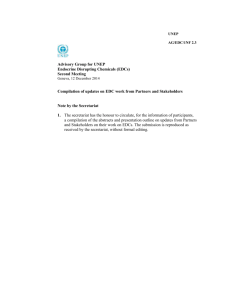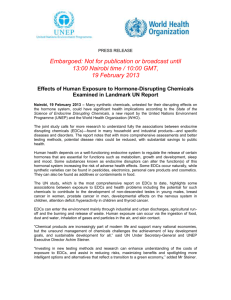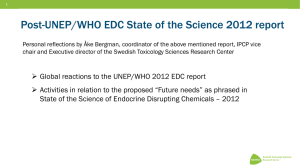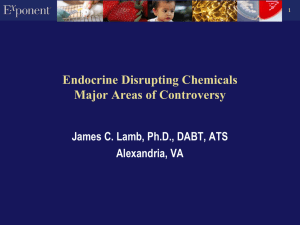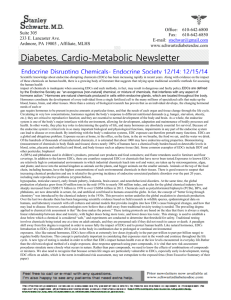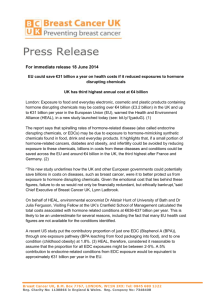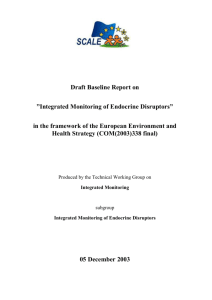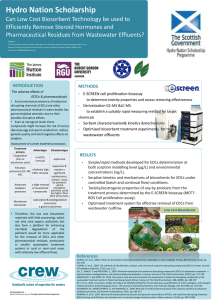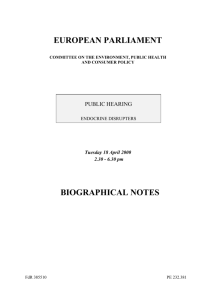Persistent Organic Pollutants and Endocrine Disrupting Chemicals
advertisement
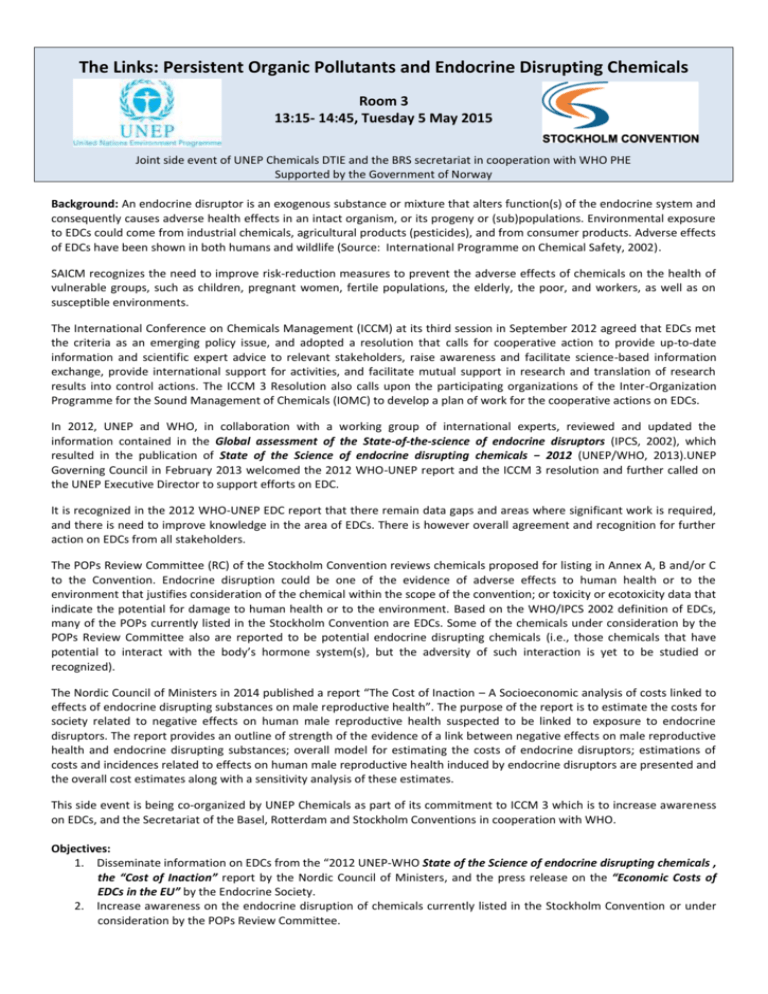
The Links: Persistent Organic Pollutants and Endocrine Disrupting Chemicals Room 3 13:15- 14:45, Tuesday 5 May 2015 Joint side event of UNEP Chemicals DTIE and the BRS secretariat in cooperation with WHO PHE Supported by the Government of Norway Background: An endocrine disruptor is an exogenous substance or mixture that alters function(s) of the endocrine system and consequently causes adverse health effects in an intact organism, or its progeny or (sub)populations. Environmental exposure to EDCs could come from industrial chemicals, agricultural products (pesticides), and from consumer products. Adverse effects of EDCs have been shown in both humans and wildlife (Source: International Programme on Chemical Safety, 2002). SAICM recognizes the need to improve risk-reduction measures to prevent the adverse effects of chemicals on the health of vulnerable groups, such as children, pregnant women, fertile populations, the elderly, the poor, and workers, as well as on susceptible environments. The International Conference on Chemicals Management (ICCM) at its third session in September 2012 agreed that EDCs met the criteria as an emerging policy issue, and adopted a resolution that calls for cooperative action to provide up-to-date information and scientific expert advice to relevant stakeholders, raise awareness and facilitate science-based information exchange, provide international support for activities, and facilitate mutual support in research and translation of research results into control actions. The ICCM 3 Resolution also calls upon the participating organizations of the Inter-Organization Programme for the Sound Management of Chemicals (IOMC) to develop a plan of work for the cooperative actions on EDCs. In 2012, UNEP and WHO, in collaboration with a working group of international experts, reviewed and updated the information contained in the Global assessment of the State-of-the-science of endocrine disruptors (IPCS, 2002), which resulted in the publication of State of the Science of endocrine disrupting chemicals − 2012 (UNEP/WHO, 2013).UNEP Governing Council in February 2013 welcomed the 2012 WHO-UNEP report and the ICCM 3 resolution and further called on the UNEP Executive Director to support efforts on EDC. It is recognized in the 2012 WHO-UNEP EDC report that there remain data gaps and areas where significant work is required, and there is need to improve knowledge in the area of EDCs. There is however overall agreement and recognition for further action on EDCs from all stakeholders. The POPs Review Committee (RC) of the Stockholm Convention reviews chemicals proposed for listing in Annex A, B and/or C to the Convention. Endocrine disruption could be one of the evidence of adverse effects to human health or to the environment that justifies consideration of the chemical within the scope of the convention; or toxicity or ecotoxicity data that indicate the potential for damage to human health or to the environment. Based on the WHO/IPCS 2002 definition of EDCs, many of the POPs currently listed in the Stockholm Convention are EDCs. Some of the chemicals under consideration by the POPs Review Committee also are reported to be potential endocrine disrupting chemicals (i.e., those chemicals that have potential to interact with the body’s hormone system(s), but the adversity of such interaction is yet to be studied or recognized). The Nordic Council of Ministers in 2014 published a report “The Cost of Inaction – A Socioeconomic analysis of costs linked to effects of endocrine disrupting substances on male reproductive health”. The purpose of the report is to estimate the costs for society related to negative effects on human male reproductive health suspected to be linked to exposure to endocrine disruptors. The report provides an outline of strength of the evidence of a link between negative effects on male reproductive health and endocrine disrupting substances; overall model for estimating the costs of endocrine disruptors; estimations of costs and incidences related to effects on human male reproductive health induced by endocrine disruptors are presented and the overall cost estimates along with a sensitivity analysis of these estimates. This side event is being co-organized by UNEP Chemicals as part of its commitment to ICCM 3 which is to increase awareness on EDCs, and the Secretariat of the Basel, Rotterdam and Stockholm Conventions in cooperation with WHO. Objectives: 1. Disseminate information on EDCs from the “2012 UNEP-WHO State of the Science of endocrine disrupting chemicals , the “Cost of Inaction” report by the Nordic Council of Ministers, and the press release on the “Economic Costs of EDCs in the EU” by the Endocrine Society. 2. Increase awareness on the endocrine disruption of chemicals currently listed in the Stockholm Convention or under consideration by the POPs Review Committee. PROGRAMME Introductory Remarks: Welcome and updates from UNEP – Elizabeth Mrema, Director, Division of Environmental Law and Conventions, UNEP Update from WHO – Maria Neira, Director, PHE WHO Remarks on relevance of EDCs to the Stockholm Convention and POPRC – Estefania Moreira, Chair, POPRC Presentations: UNEP-WHO State of the Science of endocrine disrupting chemicals , 2012 – Åke Bergman, Chair, Swetox “The Cost of Inaction: A Socioeconomic analysis of costs linked to effects of endocrine disrupting substances on male reproductive health”; “Estimated Costs of Endocrine-Disrupting Chemical Exposure Exceed €150 Billion Annually in EU” – Ing-Marie Olsson Ressner, Swedish Chemical Agency Questions & answers about the presentations Panel Discussion: “Links between POPs and EDCs” Panels Ms. Noluzuko Gwayi Senior Policy Analyst: Chemicals and Waste Cooperation Department of Environmental Affairs (DEA) Pretoria, South Africa Ms. Rikke Donchil Holmberg Senior Advisor Environmental Protection Agency Chemicals Department Copenhagen, Danemark Mr. Joseph DiGangi Senior Science and Technical Advisor International POPs Elimination Network (IPEN) Berkeley, United States of America Mr. Bernhard Johnen Emeritus Director of International Regulatory Policy, Crop Protection CropLife International Brussels, Belgium Ms. Estefania Moreira Professor Department of Physiological Sciences State University of Londrina (UEL) Brazil Moderators: Desiree Montecillo-Narvaez, UNEP Chemicals Kei Ohno Woodall, BRS Secretariat
